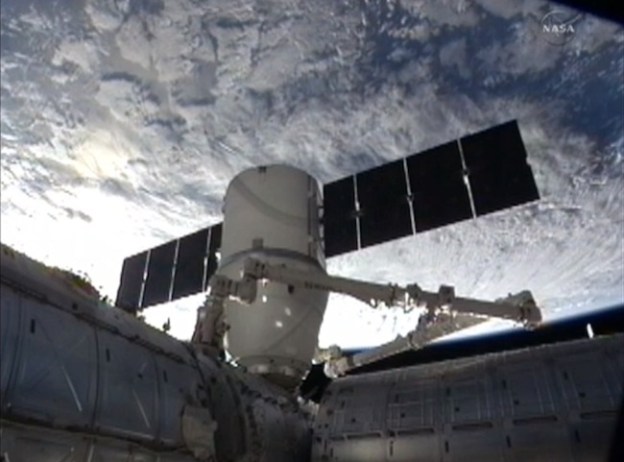 Dragon, the unmanned capsule sent into orbit by private space exploration company SpaceX’s Falcon 9 rocket last week, made its rescheduled rendezvous with the International Space Station on Sunday, despite initial worries that the entire mission would have to be scrapped almost immediately after launch due to technical failure.
Dragon, the unmanned capsule sent into orbit by private space exploration company SpaceX’s Falcon 9 rocket last week, made its rescheduled rendezvous with the International Space Station on Sunday, despite initial worries that the entire mission would have to be scrapped almost immediately after launch due to technical failure.
Eleven minutes after launch on Friday, three of the Dragon’s four thrust pods – the propulsion system necessary to ensure that the capsule would even make it into Earth orbit – failed to fire, with oxidizer pressure also low in the problematic pods. SpaceX CEO Elon Musk admitted in a press conference Friday afternoon that the realization of the problems “was a little frightening,” although SpaceX and NASA workers were able to fix the problem. The team pinpointed stuck valves, or potentially frozen oxidizer, as the culprit and resumed the mission by Saturday afternoon.
On Sunday, the Dragon capsule docked with the International Space Station and was able to deliver its cargo shipment to the astronauts and scientists on board – just one day later than scheduled. Even the docking was dramatic – albeit, intentially so – with the Dragon capsule initially snared by the Space Station’s robotic arm before being pulled into position.
SpaceX officials have promised a full investigation into what went wrong during the mission, noting that this is the third time the company has delivered materials to the International Space Station. The earlier two missions went off without a hitch – SpaceX’s delivery missions are, in part, replacing NASA’s own space shuttles, which were decommissioned in 2011 as the agency turned its attentions to Mars. Kevin Ford, commander of the International Space Station, sounded particularly forgiving after the Station’s arm had grabbed the capsule, telling the SpaceX crew on the ground that “it’s not where you start, but where you finish that counts… You guys really finished this one on the mark.”
He continued, “We’ve got lots of science on there to bring aboard and get done. So congratulations to all of you.” The cargo wasn’t entirely made up of future science projects, however; Also on board were apples and other food items from a SpaceX employee’s family orchard, according to reports. The aforementioned science objects include mouse stem cells and 640 seeds for a flowering weed to be grown for research. Additionally, some new clothes and essentials for day-to-day living, including trash bags, air and water purifiers, space-walking tools, batteries, and new computer equipment came in the delivery. All told, it was a packed little capsule.
Despite the one-day delivery delay, the Dragon capsule is believed to remain on schedule for its return journey, with splashdown in the Pacific off the coast of California still scheduled for March 25.
Editors' Recommendations
- Watch SpaceX’s Crew Dragon take one of its shortest journeys on Thursday
- China’s space station was hit by space junk
- SpaceX slow-motion video shows powerful Raptor rocket engine shutting down
- Watch SpaceX blast its megarocket engines in spectacular test
- SpaceX shares stunning night shot of its Super Heavy booster


